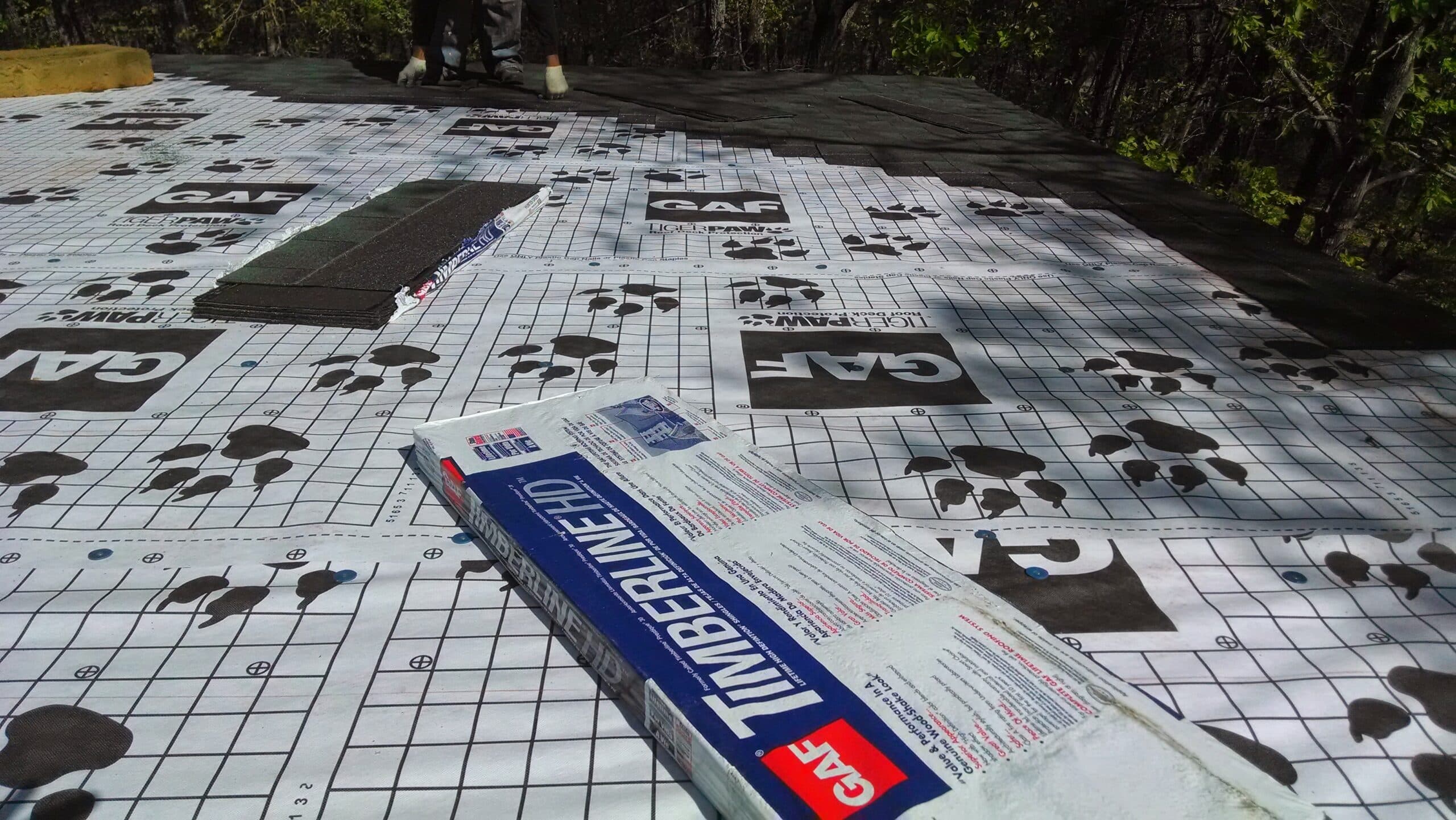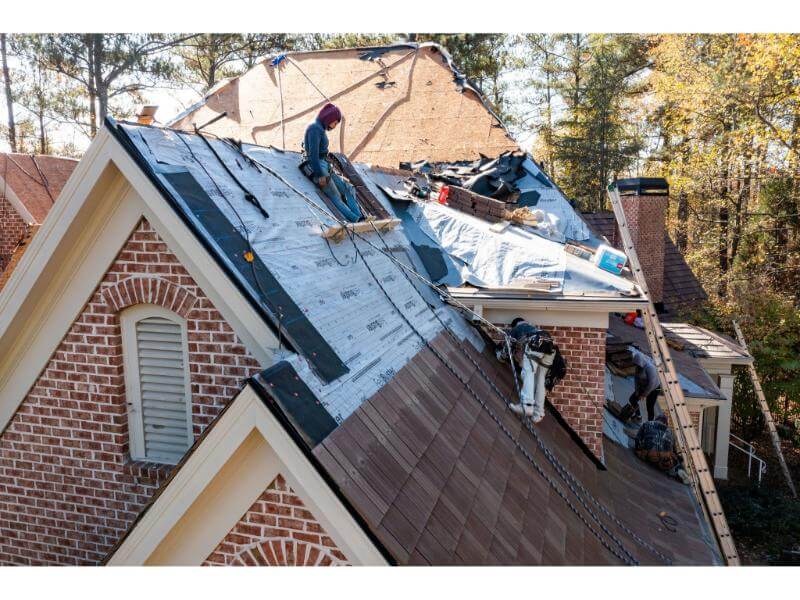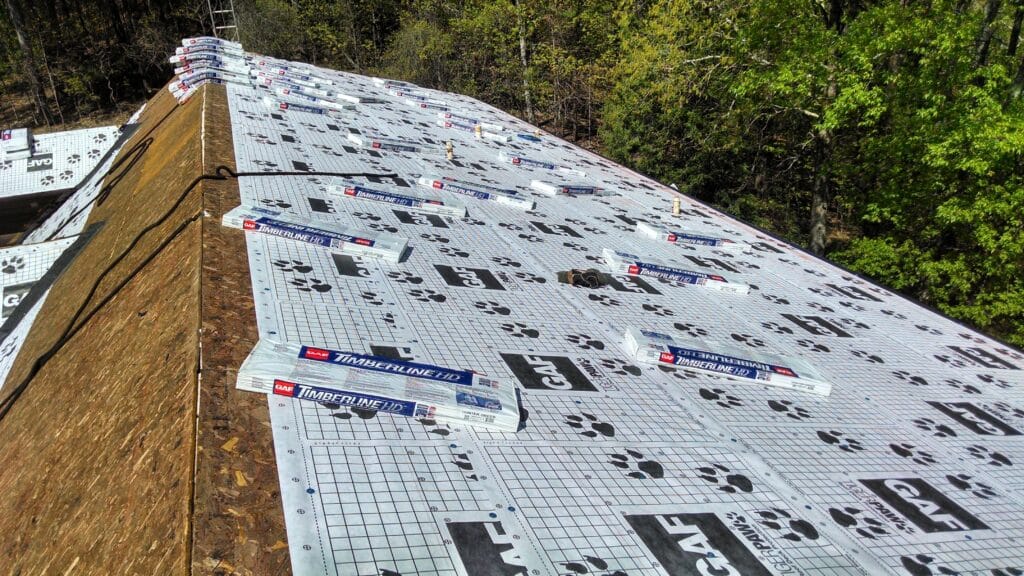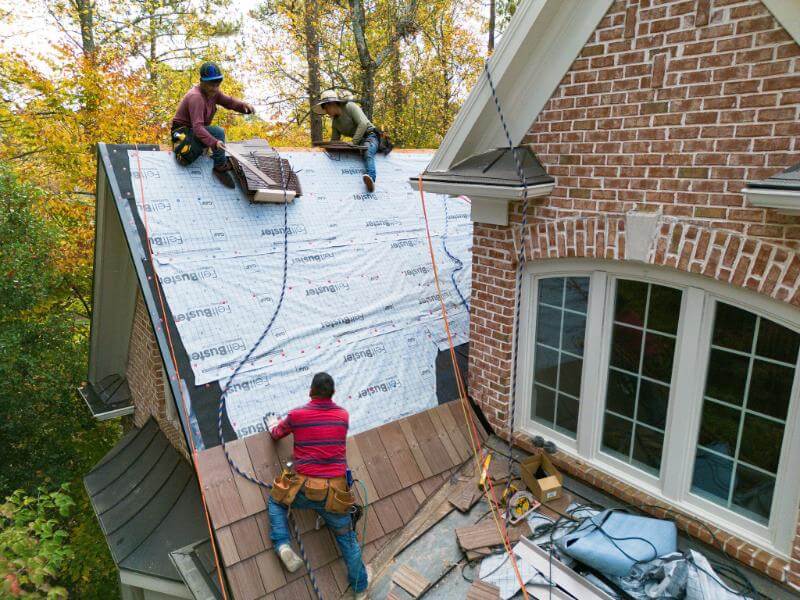
You step outside after a summer storm in Georgia and notice a dark stain spreading across your ceiling. The shingles on your roof still look intact, but water has found its way inside. For many homeowners, this is the moment they learn that what protects a house is not only the shingles or tiles on top, but the hidden layer beneath them. Roofing underlayment is the shield that stands between your home and costly water damage, ensuring durability, safety, and even compliance with manufacturer warranties.
The challenge is that not all underlayments are the same. The right choice depends on the material covering your roof, the climate conditions it must withstand, and the budget you are working with. An asphalt shingle roof may need a different solution than a slate roof, and what works in the drier highlands of North Georgia may not hold up in the humidity of Savannah.
At Mr. Roofer Atlanta, we understand these challenges because we see them every day. Our goal is to guide you toward the roof underlayment that will protect your home, fit your budget, and deliver peace of mind no matter what the Georgia weather brings.
What Is Roofing Underlayment?
Roofing underlayment is the protective layer installed between the roof deck and the final roofing material. While it is not visible once the roof is completed, it plays one of the most critical roles in ensuring the roof’s long-term performance. Its primary function is to act as a secondary barrier against water infiltration, protecting the deck and interior spaces from wind-driven rain, snow, and condensation. Beyond moisture control, underlayment enhances roof durability, adds fire resistance in some cases, and provides a more stable base for shingles, tiles, or panels to rest on.
There are three main types of roofing underlayments, each designed with unique strengths:
- Traditional felt underlayment, also known as tar paper, is made from fiberglass or cellulose saturated in asphalt. It has been used for decades and provides a basic, cost-effective layer of protection, although it is less resistant to tearing and moisture compared to newer options.
- Synthetic roof underlayment is made from engineered polymers and offers greater strength, lighter weight, improved water resistance, and better performance under Georgia’s humid conditions
- Peel-and-stick roof underlayment, also called self-adhering membrane, bonds directly to the roof deck and creates a watertight seal. This makes it particularly valuable in vulnerable areas such as valleys, eaves, and low slopes, where water intrusion is most likely.
Key Factors in Choosing the Right Roofing Underlayment
When selecting the best roofing underlayment, several factors influence performance, longevity, and cost-effectiveness. These considerations ensure the underlayment works seamlessly with the roofing material and provides reliable protection in Georgia’s demanding climate.
- Climate Conditions – Georgia’s climate is characterized by hot, humid summers, significant rainfall, and occasional severe storms. Underlayments must be able to resist moisture infiltration, withstand heat exposure, and endure rapid temperature changes. For instance, felt underlayment can degrade faster under prolonged heat, while synthetic materials offer superior resistance to warping, tearing, and mold growth. In storm-prone areas, peel-and-stick membranes are often recommended because they provide a watertight seal against wind-driven rain.
- Roof Slope – The pitch of the roof directly affects how water sheds and the amount of stress placed on the underlayment. Steep-slope roofs allow water to run off more quickly, making felt or synthetic underlayments viable choices. In contrast, low-slope or nearly flat roofs create a greater risk for water pooling, where peel-and-stick membranes are more effective because of their strong adhesion and waterproofing capability. Choosing the wrong type can lead to premature failure and leaks.
- Roofing Material Lifespan – Different roofing materials come with vastly different service lives, and the underlayment must be compatible in durability. Asphalt shingles, which typically last 20 to 30 years, can perform adequately with a mid-grade synthetic or felt underlayment. In contrast, long-lasting options like metal, slate, or clay tiles may last 50 years or more, requiring premium synthetic or self-adhering underlayments designed for extended service life. Pairing a short-lived underlayment with a long-lived roof covering can force premature roof system failure and costly replacements.
- Installation Complexity and Maintenance – Some underlayments are easier and faster to install, reducing labor costs. Felt is familiar to most contractors, but heavier and more difficult to handle in large rolls. Synthetic materials are lighter, cover more surface per roll, and reduce installation time. Peel-and-stick products require careful application, as they adhere immediately, leaving little room for error. Homeowners should also consider long-term maintenance; higher-quality underlayments reduce the risk of repairs over the roof’s life.
- Cost vs. Value – While upfront cost is a consideration, roof underlayment should be evaluated as part of the entire roofing investment. Felt is the least expensive option, but it may not provide the long-term protection needed for Georgia’s climate. Synthetic and peel-and-stick options carry higher initial costs but offer better durability, less risk of leaks, and reduced maintenance expenses over time. In many cases, spending slightly more on underlayment prevents thousands in potential water damage repairs.
- Building Codes and Warranty Requirements – Local building codes in Georgia, as well as manufacturer warranties, often dictate which types of underlayment are acceptable for certain roofing systems. For example, some shingle manufacturers require synthetic underlayment for warranty coverage, while tile or slate systems may specify peel-and-stick membranes. Ignoring these requirements can void warranties and create future liabilities.
Best Underlayment for Roof Types in Georgia

Choosing the right roof underlayment depends heavily on the type of roofing material being installed. Each roof covering interacts differently with moisture, heat, and structural stress, which makes matching the underlayment to the material critical for long-term performance. The right choice not only prevents leaks and extends the roof’s lifespan but also helps homeowners comply with building codes and warranty requirements.
Here’s a quick reference table of the best underlayment for different roof types in Georgia:
Roof Type | Recommended Underlayment | Notes for Georgia Climate |
Asphalt Shingles | Synthetic roof underlayment; Ice & water shield for valleys/eaves | Felt (#15 or #30) as a budget option |
Metal Roofing | High heat-resistant synthetic; Peel-and-stick for condensation | UV-resistant underlayment if exposed during install |
Clay & Concrete Tiles | Double-layer synthetic or self-adhered membrane | Often required by code in hot and rainy regions |
Wood Shakes/Shingles | Breathable felt or specialized ventilated roof underlayment | Allows airflow and prevents trapped moisture |
Slate Roofs | Premium synthetic or peel-and-stick; copper in historic builds | Must match the 75+ year lifespan of slate |
Flat/Low-Slope Roofs | Peel-and-stick or rubberized roof underlayment | Multiple layers recommended for waterproofing |
Below is a breakdown of the best options for the most common roof types in Georgia.
Asphalt Shingles: What Goes Under Shingles
Asphalt shingles are the most widely used roofing material in Georgia because they are cost-effective, versatile, and come in many styles. However, their performance depends on pairing them with the right underlayment. Synthetic roof underlayment is typically the best choice because it is:
- Strong
- Lightweight
- Resists tearing during installation
Unlike traditional felt, synthetic products are designed to resist Georgia’s heat and humidity, which helps them maintain integrity over time.
If you’re on a tighter budget, felt underlayment (#15 or #30) remains an option, though it comes with trade-offs such as reduced tear resistance and shorter lifespan. Many roofing professionals in Georgia recommend upgrading to at least #30 felt if synthetic is not in the budget, as it offers slightly more durability. In areas prone to heavy rainfall, such as the coastal plains or during storm season, adding an ice and water shield around valleys, eaves, and roof penetrations is highly advisable. This peel-and-stick barrier provides watertight protection where leaks are most likely to start.
Metal Roofing: Choosing the Right Underlayment Roof
Metal roofs are popular in Georgia for their energy efficiency and long lifespan, often lasting 40 to 70 years. The challenge with metal roofing is that the panels can amplify heat and create condensation underneath. For this reason, high-heat-resistant synthetic underlayment is the best choice, as it will not break down under Georgia’s intense sun. Peel-and-stick membranes are also recommended, especially in areas where condensation buildup is a concern, since they adhere directly to the roof deck and prevent moisture from seeping in.
In rural parts of Georgia, where barns and residential homes often use exposed-fastener metal roofing, UV-resistant roof underlayment is a smart investment. This ensures the underlayment can endure sunlight exposure during construction delays or in open soffit designs where the material may not be fully covered. Choosing the wrong underlayment for metal roofs can result in:
- Premature deck rot
- Corrosion of fasteners
- Higher long-term costs
Clay and Concrete Tiles: Heavy-Duty Underlayment Roofing
Clay and concrete tiles are durable and visually appealing, but because they are porous, the underlayment becomes the main waterproofing layer. In Georgia’s climate, where summer storms can bring inches of rain in a single afternoon, the best choice is a double-layer synthetic underlayment or a self-adhered membrane. These options provide superior tear resistance and long-lasting protection, which is essential since tiles are heavy and can shift during installation if the roof underlayment is weak.
Building codes in many Georgia municipalities require higher-grade roof underlayments under tile roofs due to the state’s frequent rain and periods of high humidity. Using a subpar material might save money initially, but it often leads to water infiltration issues that are difficult and expensive to repair under heavy tile systems. For coastal Georgia homes where salt air is a factor, premium underlayments also offer better resistance against long-term degradation.
Wood Shakes or Shingles: Breathable Shingle Underlayment
Wood shakes and shingles provide a natural, rustic look, but they require careful underlayment selection to prevent rot and mold. Breathable underlayments or traditional felt are most commonly used because they allow moisture to escape while still providing a protective barrier. Without this breathability, trapped moisture can shorten the life of the shakes and create structural problems.
Installers in Georgia often use spacing techniques such as skip sheathing, which promotes airflow beneath the wood roofing and reduces moisture buildup. This is especially critical in the state’s humid climate zones, where damp conditions can accelerate mold and decay. Homeowners choosing wood shakes should view the underlayment as a critical component of the system, not an optional upgrade, since improper installation can cut decades off the expected roof lifespan.
Slate Roofs: Long-Lasting Roof Underlay
Slate is one of the most durable roofing materials available, with lifespans that often exceed 75 years. However, such longevity means the roof underlayment must be equally durable. Premium synthetic underlayments or peel-and-stick membranes are recommended because they offer extended performance and protect the roof deck for decades.
In historic districts of Georgia, such as parts of Savannah, copper or specialty underlayments are sometimes used to maintain architectural authenticity and ensure that the roofing system matches the historic character of the building. Because slate roofs are also extremely heavy, the underlayment provides not only waterproofing but also structural stability, helping distribute the load and protect the deck from long-term stress.
Flat Roof Underlayment for Low-Slope Roofing
Flat and low-slope roofs present the highest risk for water problems because they do not shed rain as effectively as pitched roofs. In Georgia’s climate, where sudden downpours are common, peel-and-stick membranes or rubberized underlayments are the most reliable solutions. These products form a watertight seal that protects against pooling water and wind-driven rain.
Contractors often recommend applying multiple layers on low-slope roofs to build extra protection, particularly in commercial or multifamily buildings where roof failure can be catastrophic. In regions that experience tropical storm activity, such as coastal Georgia, this added protection becomes even more important. Proper installation is key, as even the best materials cannot compensate for poor workmanship. A continuous, well-sealed roof underlayment system ensures that flat roofs remain watertight and functional for years.
Climate Considerations for Underlayment Roofing in Georgia

Georgia’s climate is a key factor in determining the right type of roof underlayment. The state experiences long, hot summers with intense sun exposure, as well as high humidity levels and heavy rainfall. These conditions can break down underlayments that are not designed for such environments. Choosing the right materials ensures the roof system remains durable and leak-resistant for decades.
Hot Climates: UV-Resistant Underlayment Roof Materials
Georgia summers are not only hot but also marked by strong, direct sunlight that can quickly degrade roofing materials. Standard felt underlayment often breaks down under these conditions, becoming brittle and prone to tearing. UV-resistant synthetic underlayment is a far better choice, as it is engineered to withstand prolonged sun exposure without losing integrity. This feature is especially important during installation when underlayment may remain exposed for several weeks before shingles, tiles, or metal panels are installed.
For example, contractors working on a new construction project in Atlanta during July may face delays due to storms or scheduling. If the roof underlayment sits exposed, a UV-stable synthetic product will maintain its protective properties, ensuring the roof deck does not suffer from water damage. Homeowners planning reroofs should ask their contractor about UV resistance, particularly if the project is scheduled during peak summer months.
Humid Areas: Mold-Resistant Underlayment for Roofing
Georgia’s high humidity levels and frequent rainfall create a perfect environment for mold and mildew growth. Underlayment that absorbs moisture, such as basic felt, can trap water against the roof deck, leading to rot and premature failure. Mold-resistant synthetic underlayments are designed to repel water rather than absorb it, reducing the risk of fungal growth and structural damage.
This is especially important for homes in coastal or low-lying areas such as Savannah or the wetlands of South Georgia, where humidity levels remain elevated year-round. In these regions, peel-and-stick underlayments may also be recommended, as they form a watertight seal that prevents moisture infiltration in vulnerable spots like valleys and low slopes. For homeowners, investing in mold-resistant underlayment not only extends the roof’s life but also helps maintain healthier indoor air quality by reducing the risk of hidden mold growth in the attic.
Cost vs. Performance of Roofing Underlayments

Cost is one of the most common considerations when choosing roof underlayment, but it should always be weighed against performance and long-term value. While some options come with a lower upfront price, they may not provide the durability required for Georgia’s hot and humid climate. The right choice often depends on the roofing material, the expected lifespan of the roof, and the homeowner’s budget.
Disclaimer: The cost breakdown below is based on Georgia averages. Every roofing project is unique, and prices can vary depending on roof size, slope, material, and installation conditions. For accurate pricing, homeowners should contact a professional roofer for a detailed estimate.
Pricing Breakdown: Felt vs. Synthetic vs. Peel-and-Stick
Felt underlayment is the most budget-friendly option, costing roughly 15 to 30 cents per square foot. It provides basic protection but is prone to tearing, wrinkling, and moisture absorption, especially under Georgia’s humid conditions. This makes it more suitable for short-term solutions or for homeowners replacing a roof with asphalt shingles on a tighter budget.
Synthetic underlayment is more expensive, generally ranging from 30 to 75 cents per square foot, but offers significantly better:
- Durability
- UV resistance
- Water protection
Because it is lightweight and covers more area per roll, installation is often faster, which can help reduce labor costs. For most Georgia homeowners, synthetic underlayment strikes the right balance between affordability and performance.
Peel-and-stick underlayment sits at the premium end, usually costing 90 cents to $1.50 or more per square foot. While the upfront investment is higher, it provides the strongest waterproofing protection, making it ideal for vulnerable areas like:
- Valleys
- Eaves
- Low slopes
In storm-prone or coastal areas of Georgia, peel-and-stick is often worth the added cost because it prevents costly water damage and extends the roof’s lifespan.
When to Invest in Premium Underlayments vs. Budget Solutions
Deciding between premium and budget underlayment comes down to the roofing material, climate risks, and how long the homeowner plans to stay in the property. For example, a homeowner in Atlanta replacing asphalt shingles on a starter home may find that felt underlayment is sufficient, especially if they plan to sell within a few years. On the other hand, someone investing in a long-term residence with a metal or slate roof should prioritize synthetic or peel-and-stick underlayments to match the lifespan of the roof covering.
Premium underlayments are also advisable in regions of Georgia with higher rainfall or storm frequency, such as coastal areas, where water intrusion is a major concern. A single severe storm can cause thousands of dollars in interior damage if the roof fails, making the additional investment in a watertight underlayment a smart form of insurance.
Homeowners should also consider the potential savings from reduced maintenance. For instance, synthetic underlayment may cost more upfront than felt but can last two to three times longer, minimizing the need for repairs and reducing the risk of premature roof replacement. Over time, the higher initial investment often pays for itself in protection, peace of mind, and lower repair bills.
Here’s a side-by-side cost vs. benefit comparison table for easier reference:
Underlayment Type | Average Cost (per sq. ft.) | Performance Strengths | Potential Drawbacks | Best Use Case in Georgia |
Felt | $0.15 – $0.30 | Low upfront cost, familiar installation, basic water resistance | Tears easily, absorbs moisture, shorter lifespan in heat and humidity | Budget option for asphalt shingles or short-term roofs |
Synthetic | $0.30 – $0.75 | Strong, lightweight, UV- and mold-resistant, faster installation | Slightly higher material cost than felt | Most Georgia homes; balances cost and long-term durability |
Peel-and-Stick | $0.90 – $1.50+ | Watertight seal, superior waterproofing, ideal for valleys and low slopes | Highest cost, requires careful installation | Coastal or storm-prone areas; premium roofs with long lifespans |
Conclusion
Selecting the right roofing underlayment is just as important as choosing the roofing material itself. Every roof type in Georgia, from asphalt shingles to slate, performs best when paired with the proper roof underlayment. Matching the right material ensures lasting protection against the state’s hot summers, humid conditions, and heavy rains. It is also important to remember that local building codes and manufacturer warranties often specify which underlayments are acceptable, and overlooking these requirements can jeopardize both coverage and compliance.
Ultimately, your roof is one of the biggest investments you will make in your home. Protecting that investment starts with choosing the right underlayment, which safeguards against leaks, improves durability, and extends the life of the entire roofing system.
If you are planning a roofing project or considering a replacement, trust the experts at Mr. Roofer to help you select and install the best underlayment for your home. Contact Mr. Roofer today to schedule a consultation and ensure your roof is built to perform and protect for decades to come.
